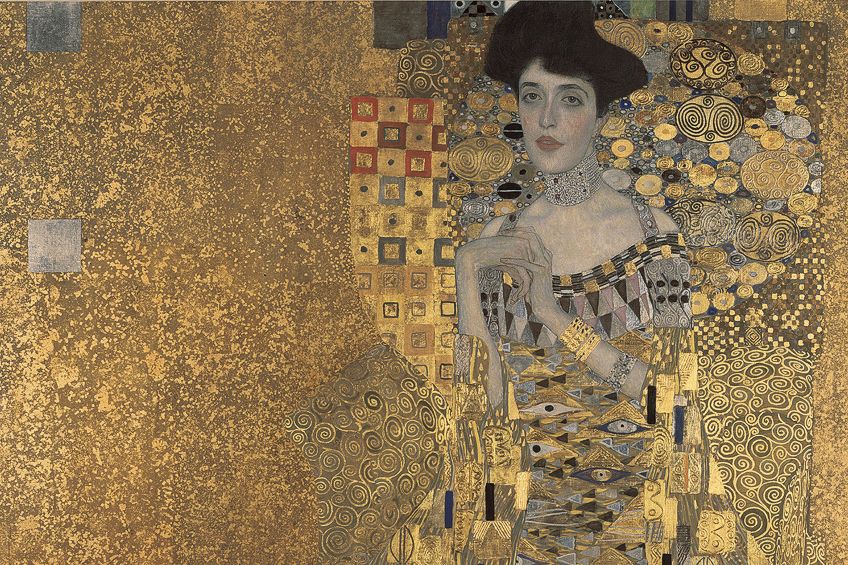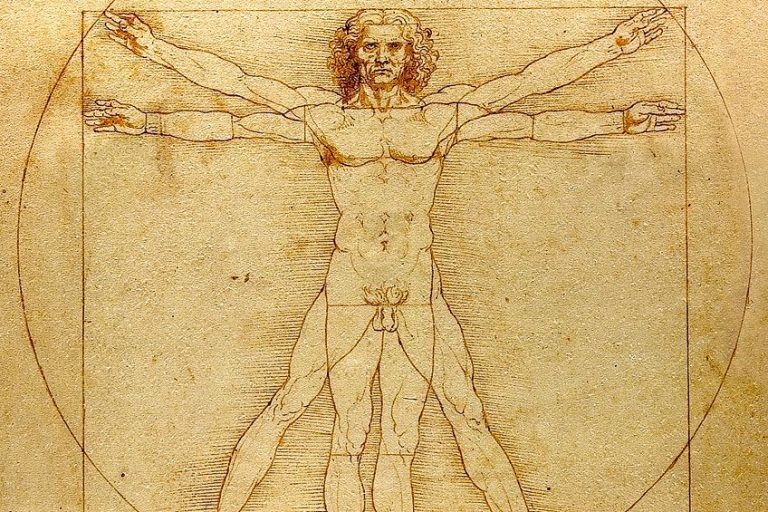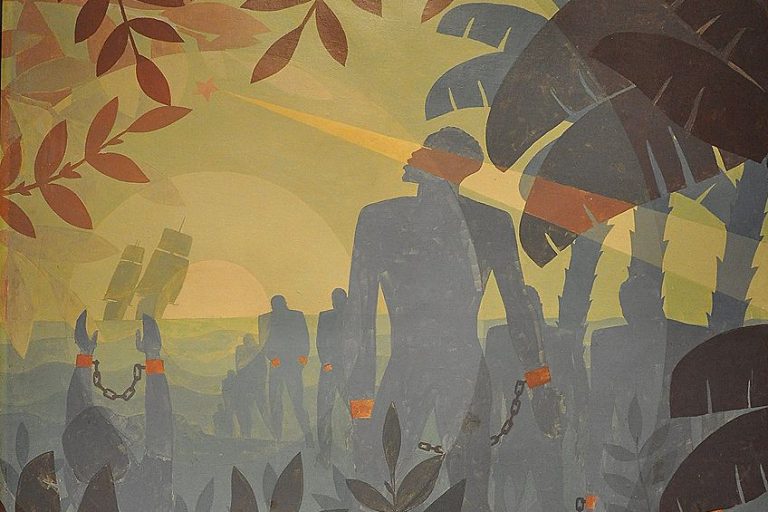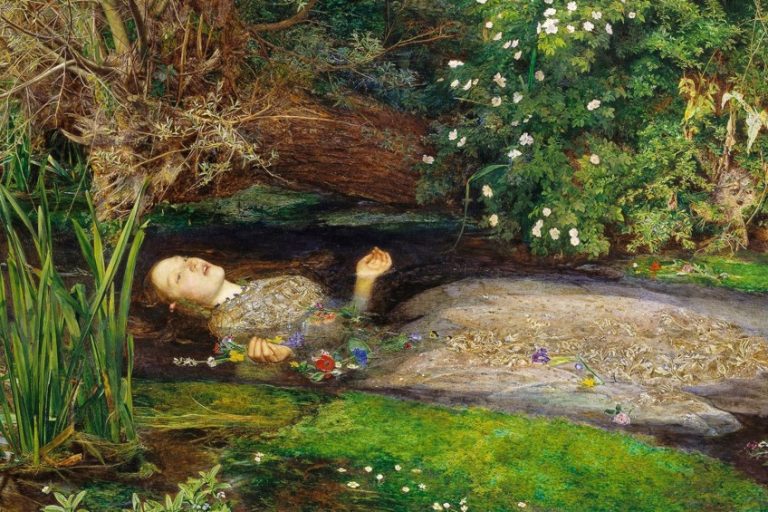Gustav Klimt Artworks – The Best Gustav Klimt Portraits and Paintings
Gustav Klimt is a renowned Symbolist painter from Austria known for his portraits, murals, and landscape paintings. His main subject matter was the female form, and his work was considered sensational for its erotic symbolism. Today, we will learn more about this eccentric bohemian painter by looking at ten examples of the most iconic Gustav Klimt artworks.
An Introduction to Gustav Klimt
Gustav Klimt was born on the 14th of July 1862 in Baumgarten, Austria. His family was very artistically talented, and along with his brother Ernst, Gustav displayed artistic skill at a very young age. Klimt was a painter in the styles of Symbolism, Art Nouveau, and a leading figure in the Vienna Secession movement.
Although mostly known for his portraits, he was also highly revered for his work on murals as well as his beautiful landscape paintings.
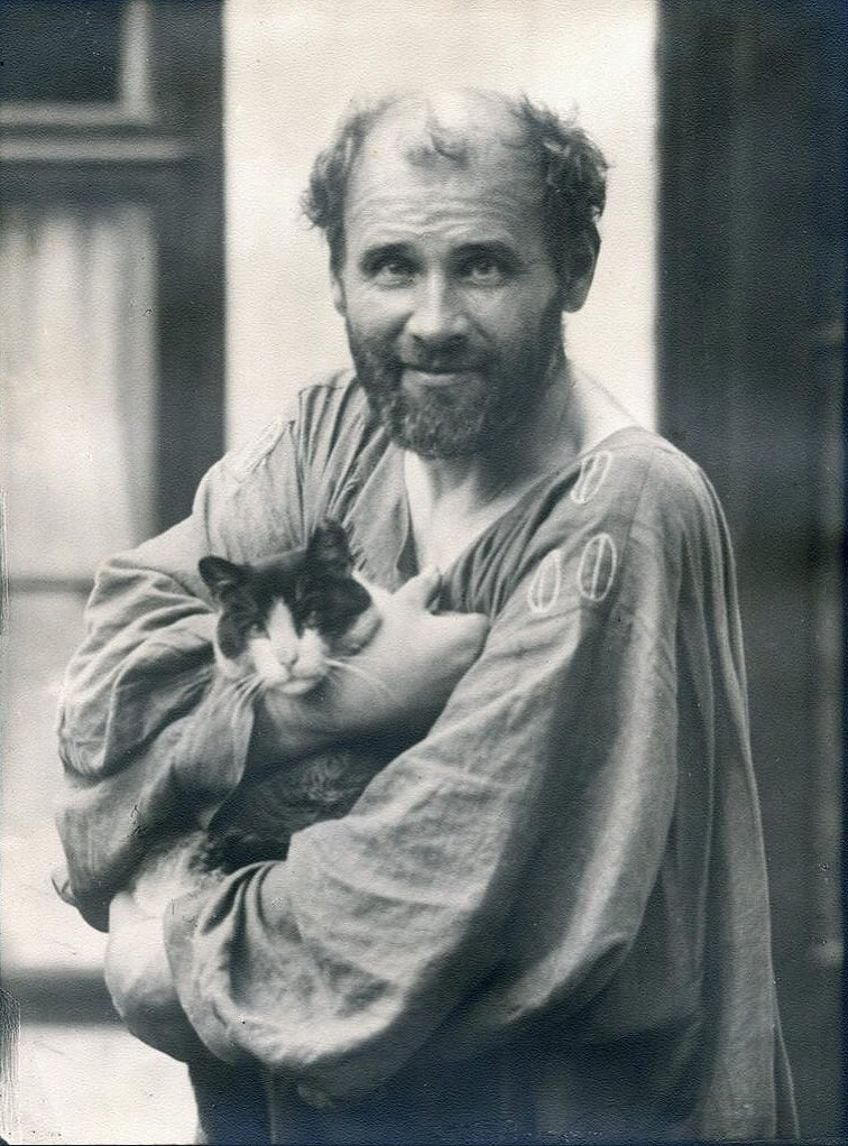
He was known for being anti-academic, and he was a rather eccentric artist who painted in a large monk’s robe, was a lover of cats, and was apparently a notorious womanizer. Klimt art displays the most influence from Japanese culture compared to its counterparts within the Vienna Secession movement, and his works are still considered masterpieces up until the present day.
A Look at 10 Famous Gustav Klimt Paintings
Most Gustav Klimt portraits and other artworks were considered highly controversial for their time, and critics thought the work was too erotic and strayed too far from the traditional ethos of the other contemporary artists of that era. However, today, art historians and the public at large appreciate his work as being masterpieces of their time, and pretty much any Gustav Klimt artworks are instantly recognizable for their sensual representation of the female form and brilliant use of colors and textures.
Today, we will take a deeper look at ten gorgeous examples of the Gustav Klimt art style, and what made these pieces so famous.
Judith and the Head of Holofernes (1901)
| Artist | Gustav Klimt |
| Date | 1901 |
| Medium | Oil on Canvas |
| Dimensions | 84cm x 42 cm |
| Location | Österreichische Galerie Belvedere, Vienna |
Klimt painted Judith and the Head of Holofernes in 1901, which depicts Judith, the biblical figure, with the head of Holofernes in her hands, having just beheaded him. This scene from the bible has been depicted by many artists since the Renaissance and was the first of two paintings that Klimt would create on this subject. Unlike previous renditions by other artists, Klimt’s painting focused on Judith as the main subject, and the head of Holofernes is barely seen, with only half his face visible in the bottom right-hand corner of the canvas.
In the painting, Judith has been painted with a seductive and provocative look on her face, looking down her nose at the viewer, conveying a sense of overt sexuality, yet unattainability.

It has been described as representing the triumph of the feminine and erotic principle over the masculine and aggressive principle. Traditionally, Judith had been depicted as a modest woman who was just fulfilling her divine duties, but in Gustav’s piece (as in his other works), she becomes the symbol of the divine and sultry femme fatale.
Her exalted elegance is amplified by the contrast between the golden radiance of the background and the pure blackness of her hair.
Her hair is further emphasized by the stylized golden trees which are fanning out on either side of her. With her torso and bare breasts visible through the semi-transparent garments, the viewer can sense that in his last moments, Holofernes had been subject to her charms and captivated by her enchanting and seductive appearance.
Beethoven Frieze (1901-02)
| Artist | Gustav Klimt |
| Date | 1901 – 1902 |
| Medium | Oil on Canvas |
| Dimensions | 2.1 m x 34.1 m |
| Location | Secession Building, Vienna, Austria. |
Klimt painted Beethoven Frieze in 1901 as part of the 14th Veinna Secessionist exhibition. It was his interpretation of Richard Wagner’s version of the 9th Symphony by Beethoven. Portraying the daily struggles that people suffer in their lifetimes, followed by the happiness and peace found in art, the exhibit also featured a sculpture by Max Klinger.
The display was meant to be temporary, so the walls were not pre-coated and paint was applied directly with light materials.

After the exhibition, the piece was preserved and removed from the Secession building, after which it exchanged owners a few times before being placed in storage. It stayed in storage until it was once again sold and placed on permanent display back at the Secession building in Vienna in 1986. The frieze is massive, the entire work weighing an incredible four tons.
It is 34 meters wide and stands just over two meters tall.
On the left wall, Klimt depicted the human yearning for joy, the associated suffering of humans inflicted with mental weakness. They implore the strong one to hear their cries and to be moved through his compassion to rise up in support of their struggle to attain happiness. On the middle wall, the humans are met with hostile forces, such as a giant being named Typhoeus that had beaten even the gods, and the three Gorgons that represent lust and anger. On the right wall, the humans finally find solace and peace in the various art forms.
Portrait of Emilie Flöge (1902)
| Artist | Gustav Klimt |
| Date | 1902 |
| Medium | Oil on Canvas |
| Dimensions | 181 cm x 84 cm |
| Location | Wien Museum, Vienna |
Emilie Flöge was part owner of Schwestern Flöge, a couture house that she ran with her sister, Helene. It was considered the most reputable salon of the bohemian fashion scene in Vienna. She was regarded as a rebel in the fashion world for her designs of unrestrictive and flowing garments, and her extreme dislike for corsets. Klimt met Flöge through his brother Ernst, who was married to Helene. When Ernst died in 1892, Gustav assumed guardianship of Helene, and she stayed with the Klimt family at their home on Lake Attersee.
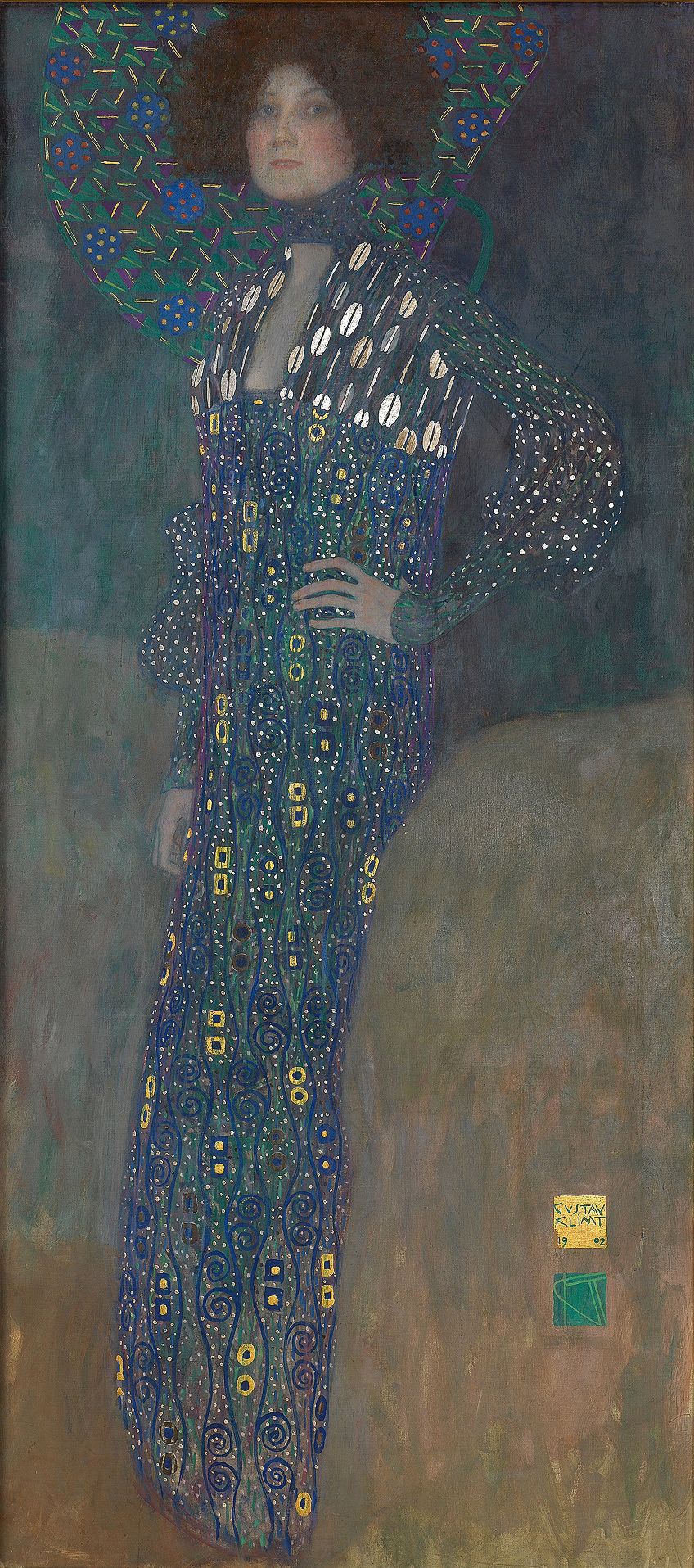
Klimt painted Emilie Flöge’s portrait in 1902, where she is depicted wearing a stunning, long gown that is embellished in patterns painted in purples, blues, blacks, and golds. Emilie is the viewer’s focal point, made even more vivid by the comparatively dull background.
This Klimt painting was considered extremely controversial for its time. It is most likely for this reason that neither her family nor Flöge liked it, and declined to hang it at their home. The city of Vienna eventually acquired it in 1908.
Although there had always been rumors regarding their relationship, Klimt and Flöge were thought not to be lovers but rather lifelong friends and partners that were more emotionally and mentally connected than physically. Whether they were romantically involved is uncertain, but it is known that they did not marry, as he preferred his existence as a bachelor.
The Three Ages of the Woman (1905)
| Artist | Gustav Klimt |
| Date | 1905 |
| Medium | Oil on Canvas |
| Dimensions | 1.8 m x 1.8 m |
| Location | Galleria Nazionale d’Arte Moderna, Rome |
This Klimt painting was made in Austria in 1905. It portrays three females in various stages of their lives, representing the cycles of life. The three figures are the focal point of the painting and have been positioned in the center of the canvas. The background feels two-dimensional and flat, lacking any sense of depth. The palette is neutral and creates a calming effect.
As is evident in other Gustav Klimt artworks, this Klimt painting makes use of his signature colorful motifs.

In this painting, the women are surrounded by two auras. A blue aura surrounds the two younger women, surrounding them in a pool of cool colors. The older woman is surrounded by her own aura, which is earthier and warmer in color. The only figures that are touching are the younger figures, representing mother and child. These younger figures also have their eyes closed, and the young figure has flowers in her hair, a symbol of spring.
The younger woman has hair that is lively and vivid, separating her from the dull hair of the older woman on the left. The oldest figure shows signs of decay such as veiny limbs, sagging skin, and a bloating stomach. Unlike the other woman, her feet are shown to display her old age in its entirety.
Danäe (1907)
| Artist | Gustav Klimt |
| Date | 1907 |
| Medium | Oil on Canvas |
| Dimensions | 77 x 83 cm |
| Location | Wurthle Gallery, Vienna, Austria |
Klimt painted Danäe in 1907 using oil paint on canvas. A popular subject for many artists in the 1900s, Danäe represented transcendence and divine love in ancient Greek mythology. This painting portrays her locked up in a tower by her father, the king of Argos, Acrisius. He believed that she needed to be hidden in a tower to keep her away from men, as he was afraid that if she had a child, the child would eventually rise up to kill him.

In the painting, Danäe is being seduced by the god Jupiter, who is represented as a golden flow of rain pouring down on her body as she curls around it in an obvious display of arousal and pleasure.
Her thighs take up almost a quarter of the canvas, which adds to the erotic overtones of this painting. Her closed eyelids, slightly parted lips, and loose stocking at her ankle all hint at her inward experience of sensuality at the moment of Zeus’s nocturnal visit. She is surrounded by a purple veil, a hint at her royal lineage. Soon after her visitation from Zeus, she gave birth to Persues, her son.
Portrait of Adele Bloch-Bauer I (1907)
| Artist | Gustav Klimt |
| Date | 1907 |
| Medium | Oil, Silver, and Gold on Canvas |
| Dimensions | 138 cm x 138 cm |
| Location | Neue Galerie, New York |
Portrait of Adele Bloch-Bauer I was completed sometime between 1903 and 1907. It was commissioned by the model’s husband, a Jewish banker by the name of Ferdinand Bloch-Bauer. The Gustav Klimt portrait of Adele was hung at the Österreichische Galerie Belvedere in 1941 after it was stolen by the Nazis. It was later reclaimed by Maria Altman, the rightful heir, in the mid-2000s after she sued the Austrian government and won her case.
This piece is considered to be the final work of Klimt’s golden phase, and the most fully characteristic of that period.
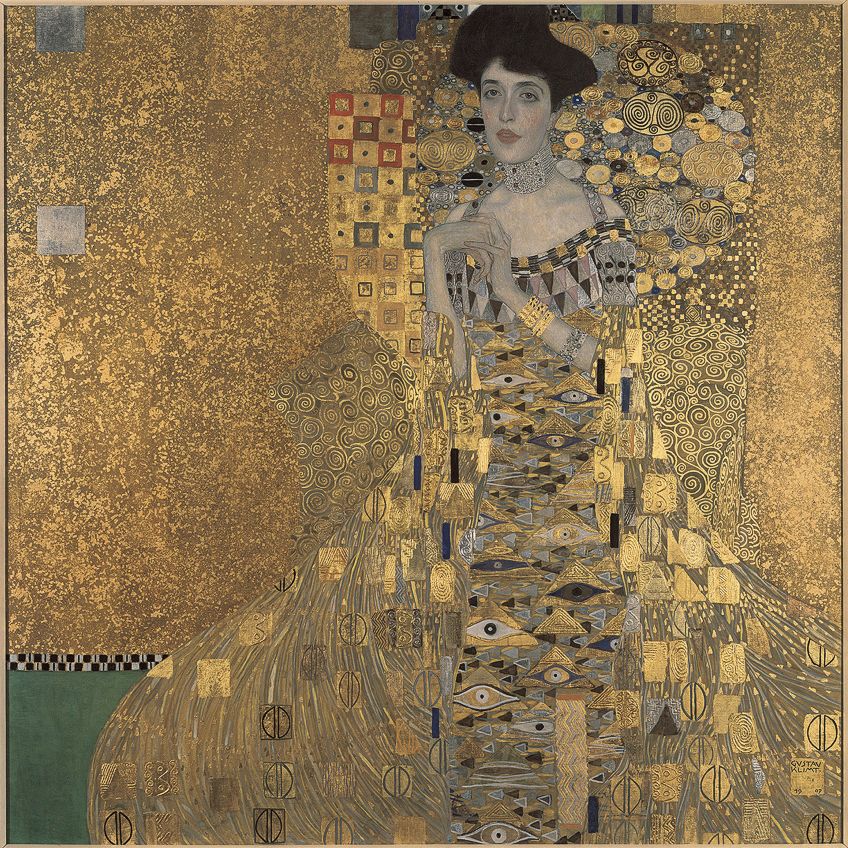
It is the first of two portraits Gustav painted of Adele Bloch-Bauer, the second of which was completed in 1912. Both of these Gustav Klimt portraits, as well as several others, were commissioned by and belonged to the Bloch-Bauer family. Portrait of Adele Bloch-Bauer I is now located at the Neue Galerie in New York and is one of the most expensive pieces of art ever sold. It depicts Adele reclining on a throne made of gold, positioned in front of a starry golden background.
Although now considered a masterpiece, the reception by critics at the time of its initial exhibition was anything but warm. After exhibiting a couple of portraits at the Mannheim International Art Show 1907, critics negatively described the paintings as “vulgar, bizarre, absurd, and grotesque.”
Hope, II (1907-1908)
| Artist | Gustav Klimt |
| Date | 1907 – 1908 |
| Medium | Oil, Gold, Platinum on Canvas |
| Dimensions | 110.5 cm x 110.5 cm |
| Location | Museum of Modern Art in New York City |
Klimt created two different portraits of a pregnant woman named Herma, who he first painted in 1903 when she was heavily pregnant and portrayed in the nude. The second painting was created in 1907 and titled Hope, II.
This time, the model is portrayed wearing a long cloak decorated lavishly in colorful geometric shapes.
She is depicted posing with her eyes closed and her head bowing down towards her swollen belly. A human skull seems to be out of place, attached to her clothing at the front, but perhaps was intentionally added to represent the risks of labor. Perhaps mourning or in the act of praying, three women can be seen at her feet, also bowing solemnly.
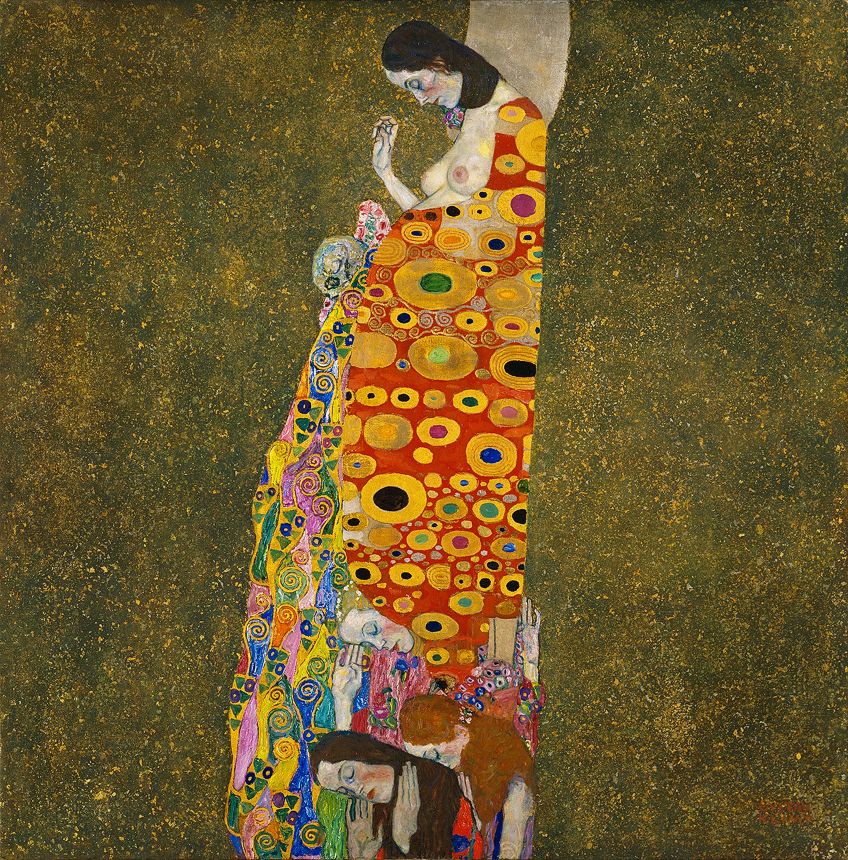
The women form the focal point of the painting, being situated in the middle third of the canvas and surrounded by a comparatively dark background with lighter specks of gold mixed in. Her clothing is decorated like Byzantine artwork with gold leaf and rich patterns and colors, although presented in a flat manner, similar to an orthodox icon.
The rich but two-dimensional garment contrasts with the skin and faces that have been so delicately painted, as well as the dark-toned color of the background.
The Kiss (1907-1908)
| Artist | Gustav Klimt |
| Date | 1907 – 1908 |
| Medium | Oil, Gold Leaf on Canvas |
| Dimensions | 180 cm x 180 cm |
| Location | Österreichische Galerie Belvedere |
Klimt painted this masterpiece at the height of his golden period. Influenced by the Art Nouveau style, the painting portrays two figures embracing, their bodies covered in beautiful, elaborately decorated robes. This is regarded as one of Klimt’s finest works and now resides at the Österreichische Galerie Belvedere museum in Vienna. As noted in other works such as Beethoven Frieze and Danäe, Klimt’s paintings always had similar themes of sensuality, love, and intimacy threaded through them.
Although this was his most revered work featuring a couple embracing, it was not his first.

It was rumored that he and Emilie had modeled for the painting themselves, but this is pure speculation that remains unproven. Other people have suggested that the woman in the painting resembles another model that Klimt was known to favor, Red Hilda. The same woman had modeled for other paintings of his such as Danaë, Lady with hat and feather boa (1909), and Goldfish (1901-1902).
In this painting, Klimt has depicted a couple embracing intimately against a flat, gold background. They are situated right at the edge of a meadow filled with flowers that end underneath the woman’s feet. The woman has a crown of flowers on her head, and the man has a crown of vines on his. He is wearing an ornate robe and she is in a long dress with a floral motif impressed on it.
We have a separate article about The Kiss by Gustav Klimt.
Avenue in the Park of Schloss Kammer (1912)
| Artist | Gustav Klimt |
| Date | 1912 |
| Medium | Oil on Canvas |
| Dimensions | 110 cm x 110 cm |
| Location | Belvedere, Vienna, Austria |
Other than his female portraits, Klimt also loved to paint landscapes. Throughout his summer days, Klimt was known to spend his time at Attersee Lake in Northern Austria. He was very inspired by the natural scenes there and often painted the fields, parks, and waterways of the area in the 1880s. It was during his visits to Salzkammergut in the 1890s, however, that he consistently started painting landscape scenes.
He enjoyed the retreat from the usual demands of commissioned work and the fast pace of city life.
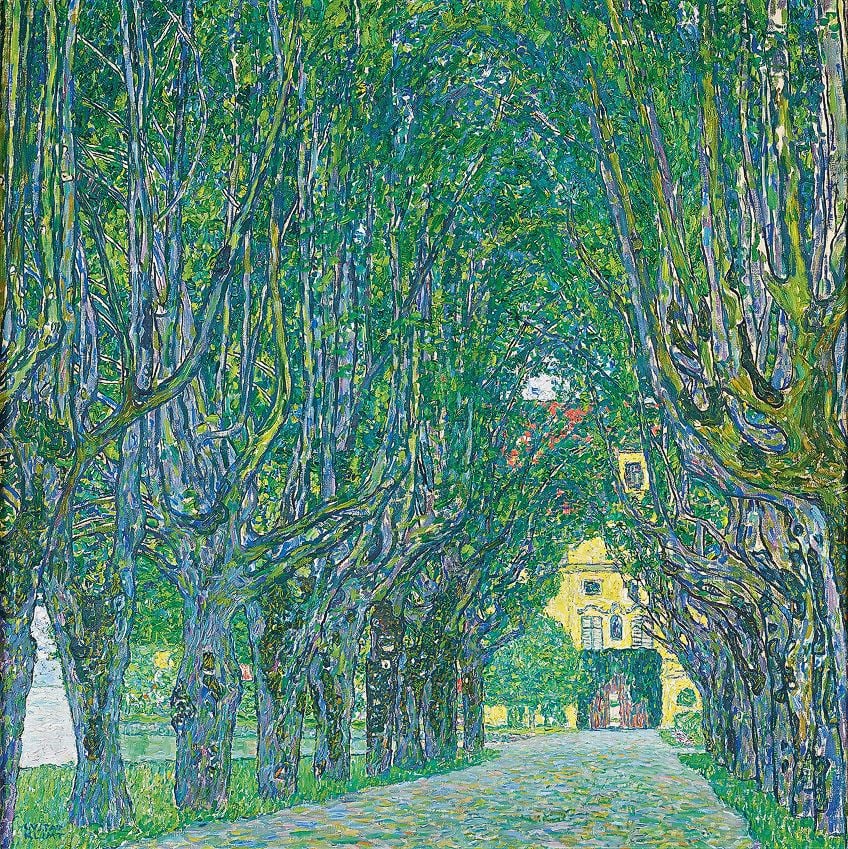
In the 1900s, when he grew tired of painting by commission, he continued painting landscapes to keep his production of new artwork in stock. Now, his landscape paintings are a highly respected addition to his artistic repertoire.
A noticeable feature of his works is the standard format and size he would apply to all of his canvases, as he was keeping in mind their final display in exhibitions.
As with the work of artists such as Egon Schiele, Klimt’s Avenue in the Park of Schloss Kammer summons the interconnected relationship of the ornamental and the natural in perfect symbiosis. His scenes of nature express his philosophies on the repetitive nature of life and biological development. His emerging Modernist tendencies are revealed in his use of abstract motifs and exceptionally decorative surfaces.
The Virgin (1913)
| Artist | Gustav Klimt |
| Date | 1913 |
| Medium | Oil on Canvas |
| Dimensions | 2 m x 1.9 m |
| Location | National Gallery in Prague |
Currently housed at the National Gallery in Prague, this painting is a colorful exhibition of Klimt’s brilliance and as with his other works, it is filled to the brim with symbolism. At first glance, it is an exquisite work of art depicting a sleeping central figure surrounded by six other people, decorated in bold greens, yellows, reds, and blues.
Once we take a deeper look, however, we start to uncover symbols that hint at the transition of the virgin to womanhood, namely the representations of fertility displayed, such as the spirals on the dress.

Her body is also provocatively posed by the subtle parting of her naked legs. As with other symbolist artists of that era, he sought to capture the emotional feeling or essence of the moment. He wanted the viewer to be drawn into the painting, to be left wondering what she could possibly be dreaming about.
The sheer abundance of flowers symbolizes the transition from girl to womanhood for the virgin. Each of the various figures surrounding the virgin is representative of a specific stage in a female’s life. Klimt hoped to engage the viewer emotionally and philosophically on various topics such as the cyclic nature of life, love, and eroticism.
In summary, we have learned about Gustav Klimt’s highly influential work within the schools of Symbolism, Art Nouveau, and the Vienna Secession. We have explored his beautiful portraits of the female form that were the source of huge controversy in their time, as well as his placid landscape paintings that followed.
Frequently Asked Questions
What Style of Art Is Gustav Klimt Known for Painting In?
Gustav Klimt was known for his contributions to several important movements during his career, including his influence as a prominent figure in the Vienna Secession movement. He was also revered for his contribution to the Symbolist movement as well as being respected for his influence on the Art Nouveau movement and Modern art. His most well-known works were initially paintings of women, but later he was also known for his paintings of landscapes.
Was Gustav Klimt Married?
Gustav Klimt was said to enjoy his life as a free-wheeling bachelor and was known as a notorious womanizer. So for this reason, he never married anyone, but he did have a lifelong partner in Emilie Flöge, with whom many people suspected he was romantically involved. However, many people have suggested that their relationship was purely platonic and that their intimacy was not physical in nature.
Which of the Gustav Klimt Artworks Is Most Famous?
The most expensive and definitely most famous Gustav Klimt painting is the Portrait of Adele Bloch-Bauer I. This piece has an incredible $135 million price tag!
Isabella studied at the University of Cape Town in South Africa and graduated with a Bachelor of Arts majoring in English Literature & Language and Psychology. Throughout her undergraduate years, she took Art History as an additional subject and absolutely loved it. Building on from her art history knowledge that began in high school, art has always been a particular area of fascination for her. From learning about artworks previously unknown to her, or sharpening her existing understanding of specific works, the ability to continue learning within this interesting sphere excites her greatly.
Her focal points of interest in art history encompass profiling specific artists and art movements, as it is these areas where she is able to really dig deep into the rich narrative of the art world. Additionally, she particularly enjoys exploring the different artistic styles of the 20th century, as well as the important impact that female artists have had on the development of art history.
Learn more about Isabella Meyer and the Art in Context Team.
Cite this Article
Isabella, Meyer, “Gustav Klimt Artworks – The Best Gustav Klimt Portraits and Paintings.” Art in Context. September 1, 2021. URL: https://artincontext.org/gustav-klimt-artworks/
Meyer, I. (2021, 1 September). Gustav Klimt Artworks – The Best Gustav Klimt Portraits and Paintings. Art in Context. https://artincontext.org/gustav-klimt-artworks/
Meyer, Isabella. “Gustav Klimt Artworks – The Best Gustav Klimt Portraits and Paintings.” Art in Context, September 1, 2021. https://artincontext.org/gustav-klimt-artworks/.


